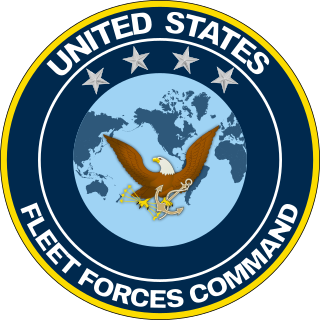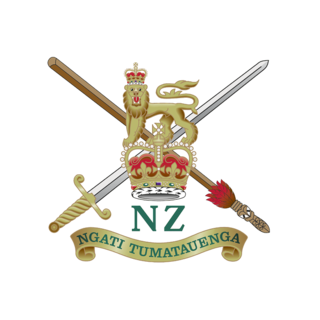Related Research Articles
The New Zealand Defence Force is the three-branched military of New Zealand. The NZDF is responsible for the protection of the national security of New Zealand and her realm, promoting its interests, safeguarding peace and security, as well as supporting peacekeeping and humanitarian missions. It consists of three services: the Royal New Zealand Navy (RNZN), the New Zealand Army and the Royal New Zealand Air Force (RNZAF), as well as 'tri-service' components. The NZDF has a strength of 15,191 made up of 9,215 regular force personnel, 3,030 reserve force personnel and 2,946 civilian members. It is supported by the New Zealand Ministry of Defence (MOD) and is commanded by the Chief of Defence Force (CDF).

The United States Fleet Forces Command (USFF) is a service component command of the United States Navy that provides naval forces to a wide variety of U.S. forces. The naval resources may be allocated to Combatant Commanders such as United States Northern Command (USNORTHCOM) under the authority of the Secretary of Defense. Originally formed as United States Atlantic Fleet (USLANTFLT) in 1906, it has been an integral part of the defense of the United States of America since the early 20th century. In 2002, the Fleet comprised over 118,000 Navy and Marine Corps personnel serving on 186 ships and in 1,300 aircraft, with an area of responsibility ranging over most of the Atlantic Ocean from the North Pole to the South Pole, the Caribbean Sea, Gulf of Mexico, and the waters of the Pacific Ocean along the coasts of Central and South America.

The Royal New Zealand Navy is the maritime arm of the New Zealand Defence Force. The fleet currently consists of nine ships. The Navy had its origins in the Naval Defence Act 1913, and the subsequent purchase of the cruiser HMS Philomel, which by 1921 had been moored in Auckland as a training ship. A slow buildup occurred during the interwar period, and then perhaps the infant Navy's most notable event occurred when HMS Achilles fought alongside two other Royal Navy cruisers at the Battle of the River Plate against the German ship, Graf Spee, in December 1939.

The New Zealand Army is the principal land warfare force of New Zealand, a component of the New Zealand Defence Force alongside the Royal New Zealand Navy and the Royal New Zealand Air Force.

Allied Command Transformation (ACT) is a military command of the North Atlantic Treaty Organization (NATO), formed in 2003 after restructuring.

The United Kingdom's Strategic Command (StratCom), previously known as Joint Forces Command (JFC), manages allocated joint capabilities from the three armed services.

Joint Helicopter Command (JHC) is a tri-service organisation uniting battlefield military helicopters of the British Armed Forces for command and coordination purposes.

Northwood Headquarters is a military headquarters facility of the British Armed Forces in Eastbury, Hertfordshire, England, adjacent to the London suburb of Northwood. It is home to the following military command and control functions:
- Headquarters, Strategic Command, formerly Joint Forces Command
- Permanent Joint Headquarters
- Commander Operations for the Royal Navy
- NATO Allied Maritime Command

Allied Joint Force CommandNaples is a NATO military command based in Lago Patria, in the Metropolitan City of Naples, Italy. It was activated on 15 March 2004, after effectively redesigning its predecessor command, Allied Forces Southern Europe (AFSOUTH), originally formed in 1951. In NATO Military Command Structure terms, AFSOUTH was a "Major Subordinate Command". The commander of JFC Naples reports to the Supreme Allied Commander Europe at the Supreme Headquarters Allied Powers Europe, Casteau, Belgium.
The Australian Headquarters Joint Operations Command (HQJOC) is the Australian Defence Force's (ADF) operational level headquarters responsible for the command and control of ADF operations worldwide. It was formed from "Headquarters Australian Theatre" (HQAST) in 2004 to reflect the changing internal structure of the ADF and the need to establish a purpose-built, co-located joint headquarters. Since December 2008, it has been based in NSW adjacent to the Kowen district of the Australian Capital Territory. The complex is known as the General John Baker Complex, named after a former Chief of Defence Force who was a strong advocate of joint command and control.

Navy Command is the current headquarters body of the Royal Navy, and as of 2012 its major organisational grouping. It is a hybrid, neither a command, nor simply an installation. Royal Navy official writings describe Navy Command Headquarters both as a physical site, on Whale Island, Hampshire, a collective formed of the most senior RN officers, and as a budgetary grouping.

Martyn John Dunne, is a retired New Zealand Army officer, a diplomat and senior public servant. He was the chief executive of the Ministry for Primary Industries. From 2011 until 2013 he was New Zealand High Commissioner to Australia based in Canberra. He was Comptroller of Customs and Chief Executive of the New Zealand Customs Service (2004–2011) after a career as soldier in the New Zealand Army from 1970 ending his military career in 2004 as Commander Joint Forces New Zealand with the rank of major general. In September 1999, Dunne led the New Zealand Force East Timor during New Zealand's largest deployment since World War II, and as the Senior National Officer and, with the rank of brigadier, commanded the Dili Command, an operational formation in the International Force East Timor, until 2000.
Land Command was a military command and formation and part of the structure of the British Army from 1995 to 2008. Its headquarters was at Erskine Barracks, at Fugglestone St Peter, some four kilometres northwest of Salisbury in Wiltshire.
The Structure of the North Atlantic Treaty Organization is complex and multi-faceted. The decision-making body is the North Atlantic Council (NAC), and the member state representatives also sit on the Defence Policy and Planning Committee (DPPC) and the Nuclear Planning Group (NPG). Below that the Secretary General of NATO directs the civilian International Staff, that is divided into administrative divisions, offices and other organizations. Also responsible to the NAC, DPPC, and NPG are a host of committees that supervise the various NATO logistics and standardisation agencies.

This article describes the current structure of the New Zealand Army. It includes the army's order of battle and the headquarters locations of major units.

The Combined Joint Expeditionary Force (CJEF) is an Anglo-French military force. It draws upon both the British Armed Forces and the French Armed Forces to field a deployable force with land, air and maritime components together with command and control and supporting logistics.

The Joint Operations Division is a component of the South African National Defence Force tasked with conducting Joint Operations involving the various arms of the SANDF.

The Joint Ground Based Air Defence Headquarters or JtGBAD HQ was a joint (non-deployable), force-generating British military formation under the operational command of RAF Air Command, sitting under No.1 Group. It was formed circa 2000 and disbanded in 2019 in favour of 7th Air Defence Group.

Special Operations Component Command (SOCNZ) provides command and oversight of the New Zealand Defence Force's special forces unit, the 1st New Zealand Special Air Service Regiment, and reports to the Commander Joint Forces New Zealand for operations. Led by a Colonel. It was initially established in 2008 as the Directorate of Special Operations, and had its role expanded when it was re-designated Special Operations Component Command on 1 July 2015.
The Commander Joint Forces New Zealand (COMJFNZ) is a senior appointment in the New Zealand Defence Force, responsible for the command of Headquarters Joint Forces New Zealand. The COMJFNZ is, in effect, the operational commander of all joint operations and exercises within the New Zealand Defence Force, and reports direct to the Chief of Defence Force. Assisting the COMJFNZ are three service component commanders—the Maritime Component Commander, the Land Component Commander, and the Air Component Commander—who are jointly responsible to the COMJFNZ and their respective service chiefs for the capability, training and operations of personnel and units from their respective services.
References
- 1 2 3 "Headquarters Joint Forces New Zealand". New Zealand Defence Force. Retrieved 11 January 2014.
- 1 2 "Roles and Organisation of the Ministry of Defence and the NZDF". Briefing to the Incoming Government 2005. Ministry of Defence. Archived from the original on 12 January 2014. Retrieved 12 January 2014.
- ↑ Ministry of Defence (2011). "Briefing for the incoming Minister of Defence 2011" (PDF). Ministry of Defence. p. 37. Archived from the original (PDF) on 27 August 2013. Retrieved 11 January 2014.
- ↑ "New chiefs for NZ Joint Forces, Army". One News. 20 February 2013. Retrieved 11 January 2014.
- Robinson, Dr. Colin D. (25 February 2022). "The Creation and Evolution of HQ Joint Forces New Zealand".
- Robinson, Colin D. (March 2023). "Rising to the challenge of joint-warfare: Colin Robinson looks at the creation of the New Zealand Joint Forces Headquarters". New Zealand International Review. 48 (2).